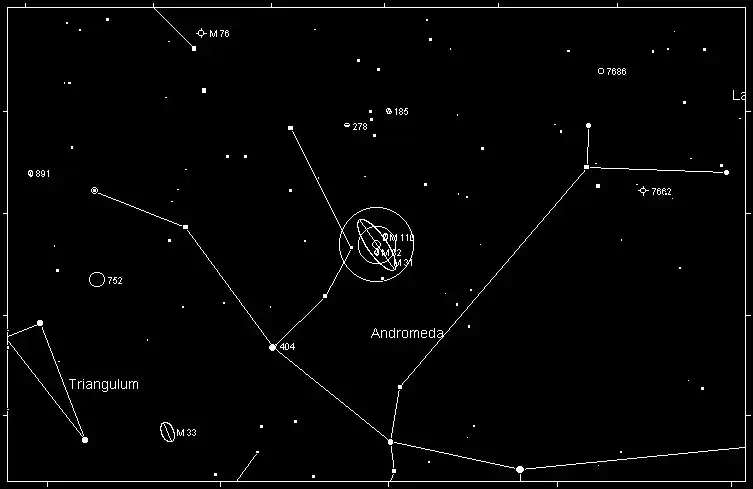Messier 31, commonly known as the Andromeda Galaxy, is the nearest spiral galaxy to our own Milky Way and one of the most studied objects in the night sky. It lies approximately 2.5 million light-years away from Earth in the constellation of Andromeda and is the largest galaxy in the Local Group, which includes the Milky Way, the Triangulum Galaxy (M33), and about 54 other smaller galaxies.
Andromeda spans about 220,000 light-years in diameter and contains roughly one trillion stars, more than double the number in the Milky Way. It is also notable because it is on a collision course with the Milky Way; the two galaxies are expected to merge in about 4.5 billion years to form a new elliptical galaxy. Despite its distance, the Andromeda Galaxy is visible to the naked eye from Earth under dark skies, appearing as a faint, elongated smudge.
Magnitude and Visibility
The apparent magnitude of the Andromeda Galaxy is 3.44, making it the brightest galaxy visible from Earth and one of the few deep-sky objects that can be seen without a telescope. However, observing it with the naked eye requires minimal light pollution and clear skies. Through binoculars or a small telescope, Messier 31 appears as an oval-shaped blur, with the central core being the brightest part.
Best Season for Viewing
Messier 31 is best observed during the autumn months, particularly from September to November. It rises in the eastern sky during the evening and culminates (reaches its highest point) in the sky at midnight during this season. In the Northern Hemisphere, autumn offers the clearest and most accessible view of the galaxy, though it can also be observed in late summer and early winter.
Observing Tips for Telescopes
To observe Messier 31 through a telescope, a low magnification eyepiece is ideal. The galaxy is so large that higher magnifications can reduce the field of view, making it harder to appreciate the galaxy in its entirety. For smaller telescopes, start with a 25mm or 32mm eyepiece.
If you have access to a larger telescope, observing the central core of the galaxy reveals more detail, and under good conditions, you might also detect the spiral arms and dust lanes. The two nearby satellite galaxies, M32 and M110, can also be seen in the same field of view with moderate-sized telescopes.
Constellation and How to Find It
The Andromeda Galaxy is located in the constellation Andromeda, which is named after the princess in Greek mythology who was saved by Perseus. To find the galaxy, start by locating the Great Square of Pegasus, a prominent asterism that dominates the autumn night sky. The constellation Andromeda extends to the northeast of the Great Square.
- Begin with the star Alpheratz, which forms the northeastern corner of the Great Square of Pegasus and is also part of Andromeda.
- From Alpheratz, trace a line of stars toward Mirach, a bright red giant in Andromeda.
- Continue along the line to the star Mu Andromedae. About halfway between Mirach and Mu Andromedae, slightly above this line, you’ll see a faint, elongated blur of light. This is the Andromeda Galaxy, Messier 31.
Using binoculars or a small telescope will reveal more detail, including the galaxy's bright core and its two companion galaxies, M32 and M110, which appear as small, fuzzy patches near the main galaxy.

History and Discovery
The Andromeda Galaxy has been known to astronomers for centuries, with the earliest recorded mention dating back to Persian astronomer Abd al-Rahman al-Sufi in 964 AD. Al-Sufi described it as a "small cloud" in his Book of Fixed Stars, and it remained known as the "Little Cloud" for many centuries.
In 1764, French astronomer Charles Messier included it as M31 in his catalog of celestial objects. At the time, the nature of M31 was not fully understood, and it was referred to as the Great Andromeda Nebula. It wasn’t until the early 20th century that American astronomer Edwin Hubble resolved individual stars in the Andromeda Galaxy using the 100-inch telescope at Mount Wilson Observatory. His discovery that M31 was not a nebula within the Milky Way but a separate galaxy fundamentally changed our understanding of the universe.
Messier 31, the Andromeda Galaxy, remains one of the most significant and easily observed deep-sky objects for amateur astronomers. Its visibility to the naked eye and accessibility through binoculars and telescopes makes it a favorite target for stargazers, particularly during the autumn months. As the closest spiral galaxy to our own Milky Way, it holds a unique place in both our past and future as a constant companion in the night sky and a glimpse into the eventual future collision of our galactic neighborhood.
